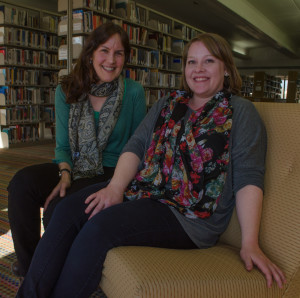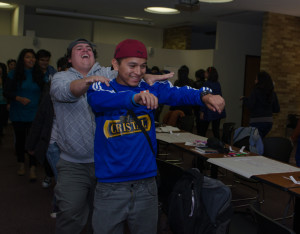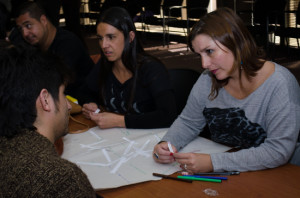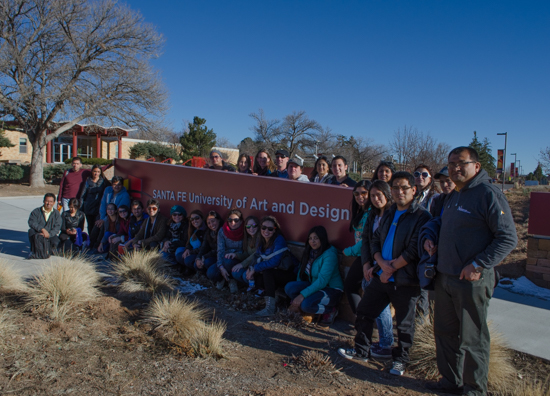Tags
Related Posts
Share This
Vacation English Immersion
“Like a fire burning in my heart,” says Jaime Pavez. “Like a simple, woman’s kiss.”
“He’s a Latin lover,” says Massiel Pereda.
The class laughs.
“What color is he describing?” asks ESL instructor Rachel Moran.
“Red,” the class responds.
The students are attempting to describe a color without using the name of the color itself. Moran hands out envelopes with crayons inside and tells the students not to let the others see it. They each write descriptions in their notebooks then read them aloud to the class. By avoiding naming the color, the students are forced to consider other words that will get the same point across to their classmates.
It is the first session of SFUAD’s Vacation English Immersion (VEI). On Feb. 17, a group of 27 students and faculty from Chile and Peru arrived at the school to take part in an intensive, three-week course to improve their English skills. They have been separated by varying skill levels. Moran’s class meets in a small room in Benildus Hall. A canvas bag hangs from the wall and reads: “Good grammar is sexy.”
As a student worker in the International Office, I greeted the students as they arrived on campus. Six students from Peru entered St. Mike’s Hall, hauling their wheeled luggage behind them. A brown trail of foot prints marred the tile floor, tracked in from the previous night’s snow. The Contemporary Music students set up drums in the cafeteria and beat out rhythms that echoed through the building as the cafeteria staff donned festive Mardi Gras masks. The Peruvian students received their welcome folders and an invitation to enjoy their first meal at SFUAD: a spread of New Orleans cuisine. Another contingent arrived just after 3 p.m., this time from Chile. I showed a group of six students to their rooms in King Hall. It is the first time that any of them have lived in a dorm (they don’t have dorms in Chile or Peru) and for many of them, it is their first time in the U.S.
Jaime Pavez is the vocalist and bass player in a band back in Chile. He hopes to find some time to play some music while he is here. “Do you know any famous musicians from Chile?” he asks.
“I’m an American,” I say, “so I don’t know anyone from outside of my own country.”

Director of English Language Programs Andrea Patterson and ESL instructor Rachel Moran both work very hard to make the VEI as successful as possible for all involved. Photo by Ashley Costello.
“That’s funny,” he says. “You’re the fifth person here that’s told me that.”
This is SFUAD’s third VEI since Andrea Patterson came aboard as director of English Language Programs more than a year ago. The first took place in April 2014 with a group of students from Costa Rica. The second occurred during ArtFest in the summer, and included more than 200 international students. Patterson describes herself as a background organizer and troubleshooter.
“I like to stop in to the classrooms occasionally and make sure the students are doing OK,” she says. “Being away from home can be difficult and sometimes they are up and down emotionally.”
In addition to her work on the VEI events, Patterson oversees an academic ESL course for all international students each semester. She is also working on building and recruiting for a year-round, intensive English program.
“I spend so much time planning,” she says, “I like to see it all in motion. I get to look at it from a bird’s-eye view. I see myself in the students and I learn very reflectively what the process is like.”
Rachel Moran estimates that she has taught at least seven Vacation English Immersion courses at SFUAD in the last four years. Though she is fluent in Spanish, she does not speak Spanish in her classes. “Why come all this way and have your teacher speak fluently to you in your own language?”
Moran has taught English for nearly 30 years. She went abroad for the first time when she was 18 years old to study in England. While there, she obtained her bachelor’s degree and stayed in the country for 10 years. “Traveling changes you at the core,” she says. “It ignites something inside of you.” Teaching non-native speakers reminds Moran of her time spent abroad. “I’ve taught in many different universities in America and I enjoy it because it allows me to live everywhere in the world all the time. It’s what keeps me balanced and able to live in my own country. It’s also the one thing that I can do well.”
For a non-native speaker, being immersed in an English-speaking culture presents the opportunity to strengthen one’s linguistic muscles.
“Living in a place creates a greater need to learn the language so you can express yourself,” says David Wong.

Sebastian Riquelme and Stephano Edwards dancing to Mambo No.5 during Speed Friending session. Photo by Ashley Costello.
Moran leads the students in a writing exercise. She gives them seven minutes to write about who they are, why they are here and what their goals are. After they have finished, the students exchange notebooks and read about each other. They are then asked to introduce each other to the rest of the class.
“People don’t always give you seven minutes to organize your thoughts in another language,” says Moran.
As the students tell the class what they have learned about their new friends, Moran has to ask a few of them to speak up. “You have to be twice as clear and twice as loud as native speakers,” she says.
Some of the students struggle with the proper way to begin their introductions. The definite article, “this,” when used to describe a person, is considered rude to Spanish speakers. “To say ‘This is’ when referring to a person sounds like you’re calling them an object,” says David Wong.
Moran instructs the students to partner up and create secret handshakes. “In America, we don’t do the kiss hello,” says Moran. “We shake hands or we might hug.”
David Wong and Marcela Cerda clasp hands and push their thumbs together. Sebastian Plaza and Margarita Urbina shake with their left hands instead of their right. Pilar Juan and Jaime Pavez concoct an elaborate gesture that involves spinning their arms over each other’s heads.
The class takes a break and Wong pulls out his cell phone to show me a language app. A grid containing phonetic symbols fills the screen. “Sometimes English can be so confusing,” he says, “In Spanish, the vowels always make the same sound. In English, the vowels will make one sound in one word, and a different sound in another word. How do you know the correct way to pronounce it when you see it?”
It’s a fair point. “There are different rules depending on the other letters in the word,” I say. “Sometimes you have to use clues from words that you already know how to pronounce. But other times you just have to hear other people say the word. There are some words that I’ve pronounced one way my entire life, only to find out years later than I’ve been saying incorrectly.”
The morning sessions are followed in the afternoon by skill-based workshops that range from learning about the culture of Santa Fe and New Mexico to an activity called “speed friending.” Similar to speed dating, it involves students of varying levels of English skills getting to know one another through provided prompts. The 27 students have been divided into three separate classes based on their skill-level of English. Moran is teaching the advanced class, while Dafyd Rawlings and Jenny Sanborn teach the other levels.

Marilyn Buzeta intently listens as Jaime Pavez practices his English during the Speed Friending session.
“One of the great things about Dafyd,” says Andrea Patterson, “is that he has a master’s in English, but he also has a master’s in Architecture. So he really understands art and design, which provides a different input in the program.
Patterson says Sanborn has done every single VEI at SFUAD. “This is the fourteenth Vacation English Immersion. She typically teaches the lower skill level. She’s very outgoing and gets everyone involved.”
After getting settled in their dorm rooms, I take the students for a brief tour of the campus and then proceed to the cafeteria for dinner. A pasta dish is served with tomato sauce. Gaston Silva says it is too spicy for him. Nibaldo Valenzuela, an English instructor from Chile, agrees that the cafeteria food is spicier than he is used to.
“When the Indian students came from Pearl Academy back in October, they thought the food was too bland,” I tell him.
Pavez and Silva explain the history of their country. They speak of the brutal regime of Augusto Pinochet and the murder of Chilean musician, Victor Jara, who was an outspoken critic of the government. He was killed in a stadium along with thousands of others by the Chilean Army. Later, Silva tells me that I look like Chilean actor, Jean Philippe Cretton and shows me a picture of him on his phone. I tell him that I’m fine with this, as I’m tired of people telling me I look like Jeremy Renner.
After a long, enjoyable conversation, several female students rise to leave the table. Massiel Pereda approaches me and explains that in her country, it is traditional to exchange a kiss on the cheek when saying hello and goodbye. I feel a little embarrassed, but follow the custom as the girls depart from the cafeteria. I realize I’m becoming a little immersed myself.







 Jackalope Magazine is the student magazine of Santa Fe University of Art and Design. Building on the interdisciplinary nature of our education, we aim to showcase the talent of our university and character of our city.
Jackalope Magazine is the student magazine of Santa Fe University of Art and Design. Building on the interdisciplinary nature of our education, we aim to showcase the talent of our university and character of our city.
This is a really good report you made Andrew, I stil think food here it is to spicy lol, anyway, thanks for the hook up, you have been very helpful and nice to all of us.
best regards
Nice article
OMG!!! Why I didnt read about this before! This explain exactly how was the experience up there! Thanks for sharing Andrew!
Thanks, Gaston!